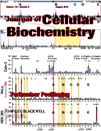
Cell Metabolism
Scope & Guideline
Illuminating the pathways of health and disease.
Introduction
Aims and Scopes
- Metabolic Pathways and Regulation:
Research on the mechanisms of metabolic pathways, including glycolysis, fatty acid metabolism, and amino acid metabolism, and how these pathways are regulated in health and disease. - Immunometabolism:
Studies exploring the intersection between metabolism and immune cell function, including how metabolic reprogramming influences immune responses and inflammatory diseases. - Microbiome and Metabolism:
Investigations into the role of the gut microbiome in metabolic health, including how microbial metabolites influence host metabolism and disease states. - Nutritional and Dietary Interventions:
Research on the effects of various dietary patterns, fasting, and nutritional interventions on metabolic health and disease prevention. - Metabolism and Aging:
Exploration of how metabolic processes change with age, contributing to age-related diseases and the potential for interventions to promote healthy aging. - Cancer Metabolism:
Studies on the metabolic adaptations of cancer cells, including how alterations in metabolism can influence tumor growth, immune evasion, and treatment resistance. - Cellular and Organismal Metabolism:
Research that examines metabolic processes at both the cellular level and how these processes affect whole-organism physiology.
Trending and Emerging
- Personalized Medicine and Metabolism:
A growing focus on how individual metabolic profiles can inform personalized treatment strategies, particularly in metabolic disorders and cancer. - Metabolic Interventions for Disease Prevention:
Increased research on therapeutic interventions, such as dietary modifications and pharmacological agents, aimed at altering metabolic processes to prevent or treat diseases. - Integration of Multi-Omics Approaches:
Emerging studies utilizing integrated multi-omics approaches (genomics, proteomics, metabolomics) to gain comprehensive insights into metabolic regulation and its implications for health. - Role of Circadian Rhythms in Metabolism:
A rising interest in how circadian rhythms influence metabolic processes and how disruptions in these rhythms can lead to metabolic diseases. - Therapeutic Targeting of Metabolic Pathways in Cancer:
An increasing emphasis on targeting metabolic vulnerabilities in cancer cells as a strategy for developing novel cancer therapies. - Impact of Environmental Factors on Metabolism:
Research exploring how environmental factors, including diet, microbiome, and lifestyle, interact with metabolism and influence health outcomes.
Declining or Waning
- Traditional Metabolic Enzyme Studies:
There seems to be a reduction in studies focused solely on classical metabolic enzymes without considering their broader physiological context or interactions with other cellular processes. - Basic Metabolic Characterization:
Research that primarily describes metabolic pathways without linking findings to disease relevance or translational implications appears to be less frequent, as the field moves towards more integrative and applied studies. - Static Models of Metabolism:
There is a waning interest in static models of metabolism, with a shift towards dynamic and systems biology approaches that capture the complexity of metabolic networks in vivo.
Similar Journals

CELLULAR AND MOLECULAR LIFE SCIENCES
Fostering Breakthroughs in Cellular and Molecular ResearchCELLULAR AND MOLECULAR LIFE SCIENCES, published by SPRINGER BASEL AG, stands as a premier journal dedicated to advancing the field of cellular and molecular biology. With an impressive 2023 impact factor reflected in its Q1 rankings across key categories—including Cell Biology, Molecular Biology, and Pharmacology—it serves as a critical platform for researchers aiming to disseminate high-quality findings in these dynamic fields. Operated under an open access framework, the journal allows broader accessibility to groundbreaking research, fostering collaboration amongst scientists globally. Based in Switzerland, CELLULAR AND MOLECULAR LIFE SCIENCES has been at the forefront of scientific publishing since 1952, adapting to contemporary scientific challenges and trends, ultimately shaping the future of life sciences.

BIOCHIMICA ET BIOPHYSICA ACTA-BIOENERGETICS
Leading the Charge in Biochemical DiscoveriesBIOCHIMICA ET BIOPHYSICA ACTA-BIOENERGETICS is a prestigious journal published by Elsevier, dedicated to advancing the fields of biochemistry, biophysics, and cell biology. Established in 1967, this journal is committed to disseminating high-quality research that unveils the molecular mechanisms of bioenergetics, encompassing a wide range of topics from mitochondrial function to energy metabolism. With an exceptional impact factor and a current ranking in the Q1 quartile across multiple categories—specifically ranked #13 in Biophysics and featuring strong positions in Biochemistry and Cell Biology—this journal is recognized for its influential contributions to the scientific community. Scholars, researchers, and students globally benefit from its rigorous peer-review process and access options, although it is not currently open access. By providing a platform for innovative research, BIOCHIMICA ET BIOPHYSICA ACTA-BIOENERGETICS plays a critical role in fostering scientific advancement and collaboration among professionals in the field.

JOURNAL OF PHYSIOLOGY AND BIOCHEMISTRY
Unveiling Cellular Secrets for Biomedical InnovationJOURNAL OF PHYSIOLOGY AND BIOCHEMISTRY, published by Springer in the Netherlands, serves as a pivotal platform for disseminating high-quality research within the fields of physiology, biochemistry, and related biomedical sciences. With an impressive impact factor reflected in its categorization as Q2 in Biochemistry and Q1 in Medicine (miscellaneous), this journal fosters a vibrant community of scholars dedicated to advancing knowledge and innovation. The journal’s broad scope encompasses a wide range of topics from cellular mechanisms to systemic physiology, making it relevant for both theoretical and applied sciences. Researchers and practitioners are encouraged to utilize the available Open Access options to reach a wider audience. The journal’s continuous contribution to the scientific dialogue since its inception in 1996 positions it as a key resource for professionals and students alike, facilitating the exploration of cutting-edge topics and collaborative research opportunities.

TRENDS IN CELL BIOLOGY
Connecting Researchers to Cutting-Edge Cell BiologyTRENDS IN CELL BIOLOGY, published by CELL PRESS, is a premier journal in the field of cell biology, recognized for its high-impact contributions since its inception in 1991. As a distinguished member of the Q1 quartile within its category, the journal holds an impressive Scopus ranking of #8 out of 285, placing it in the 97th percentile of the field, which underscores its reputation for excellence. The journal serves as an essential resource for researchers, professionals, and students who are engaged with groundbreaking advancements in biochemistry, genetics, and molecular biology. Although it is not open access, it provides critical insights into the latest trends, reviews, and advancements in cell biology, making it a crucial tool for anyone committed to understanding the complexities of cellular systems. With a focus on innovative and transformative research, TRENDS IN CELL BIOLOGY continues to shape the discourse in cell biology and enhance the scientific community's knowledge.

BIOCHEMICAL JOURNAL
Connecting Ideas, Inspiring Discoveries in BiochemistryBIOCHEMICAL JOURNAL, published by Portland Press Ltd, stands as a leading publication in the fields of Biochemistry, Cell Biology, and Molecular Biology, reflecting a commitment to advancing scientific knowledge since its inception in 1945. With a distinguished Q1 ranking across these categories and impressive Scopus rankings, the journal serves as an invaluable resource for researchers, professionals, and students alike, facilitating critical discoveries and innovative research practices. Although not currently offering open access, the journal provides a platform for high-quality peer-reviewed articles, ensuring rigorous standards in the dissemination of biochemical research. Spanning over seven decades and continuing through to 2024, the BIOCHEMICAL JOURNAL fosters an environment where cutting-edge biochemical research thrives, supporting the global scientific community's efforts to address complex biological questions and enhance our understanding of fundamental cellular processes.

JOURNAL OF MOLECULAR ENDOCRINOLOGY
Innovating Research at the Intersection of Hormones and BiologyJOURNAL OF MOLECULAR ENDOCRINOLOGY, published by BIOSCIENTIFICA LTD, is a prestigious academic journal that has made significant contributions to the fields of endocrinology and molecular biology since its inception in 1988. With an impressive impact factor that places it in the Q1 category for Endocrinology and Q2 for Molecular Biology, this journal is recognized for its rigorous peer-reviewed research that addresses key questions at the intersection of molecular mechanisms and hormonal regulation. The journal's accessibility within the Scopus rankings, notably positioned 45th out of 128 in Endocrinology, highlights its relevance and influence in shaping contemporary scientific discourse. Although the journal does not currently offer open access options, it remains an essential resource for researchers, professionals, and students eager to explore groundbreaking discoveries and advancements in the hormonal sciences. The JOURNAL OF MOLECULAR ENDOCRINOLOGY continues to pave the way for critical exploration and innovation, ensuring its place as a vital publication for the advancement of knowledge in molecular endocrinology.

Journal of Ovarian Research
Shaping the future of gynecological and oncological studies.The Journal of Ovarian Research, published by BMC, is a premier open access journal dedicated to advancing knowledge in the fields of Obstetrics and Gynecology as well as Oncology. Established in 2008, this journal is based in the United Kingdom and has garnered significant attention, evidenced by its impressive Q1 ranking in Obstetrics and Gynecology and Q2 in Oncology as per the 2023 category quartiles. The journal boasts a notable Scopus ranking, placing it at #32 out of 209 in its primary field, showcasing a staggering 84th percentile ranking, indicating its relevance and impact on ongoing research in these disciplines. By facilitating unrestricted access to high-quality research through its open access model, the Journal of Ovarian Research serves as a vital resource for researchers, clinicians, and students alike, fostering collaboration and innovation in ovarian health studies.

CELL PROLIFERATION
Shaping the Future of Medicine Through Cellular InsightsCELL PROLIFERATION, published by Wiley, is a leading open-access journal that has been at the forefront of research since its inception in 1968. With an impact factor that solidifies its position in the Q1 category of both Cell Biology and Medicine (Miscellaneous), this journal serves as a premier platform for disseminating groundbreaking studies in the field of cellular and molecular biology. The journal is renowned for its rigorous peer-review process and comprehensive coverage of topics related to cell growth, division, and differentiation, making it an invaluable resource for researchers, professionals, and students alike. With its notable Scopus ranking of #30 in Biochemistry, Genetics, and Molecular Biology: Cell Biology, and a robust open access model since 2019, CELL PROLIFERATION ensures that cutting-edge research is accessible to a global audience, fostering collaboration and innovation across the scientific community. Located in the United Kingdom, the journal remains committed to enhancing the understanding of cellular processes, thereby influencing developments in medicine and biotechnology.

Protein & Cell
Advancing Knowledge in Biochemistry and Cell BiologyProtein & Cell, published by Oxford University Press, is a distinguished international journal focusing on cutting-edge research in the fields of biochemistry, biotechnology, cell biology, and drug discovery. This open access journal, active since 2014, is dedicated to disseminating innovative findings that advance our understanding of protein functions and cellular processes, making it an essential resource for researchers, professionals, and students alike. With an impressive 2023 impact factor reflected in its Q1 ranking across multiple categories such as Biochemistry, Drug Discovery, and Cell Biology, 'Protein & Cell' stands at the forefront of scientific research, driving collaboration and discussion in the scientific community. Researchers can access the journal freely online, fostering a global exchange of knowledge and contributing to significant advancements in medicine and biotechnology. Located in the United Kingdom, the journal strives to be a pivotal platform for impactful research that influences future studies and applications.

JOURNAL OF CELLULAR BIOCHEMISTRY
Pioneering Innovative Discoveries in Cellular BiologyJournal of Cellular Biochemistry is a premier academic journal dedicated to advancing the field of biochemistry and cellular biology. Published by Wiley, this influential journal has a significant impact factor that underscores its relevance and authority within the scientific community. With its ISSN 0730-2312 and E-ISSN 1097-4644, the journal has been on the frontier of research since its inception in 1982, and is expected to continue publishing cutting-edge studies through 2024. As evidenced by its ranking in the 2023 Scopus Quartiles, it holds a rank of Q2 in Biochemistry and Q3 in both Cell and Molecular Biology, placing it among the top tiers of scientific journals in these disciplines. The Journal of Cellular Biochemistry serves as a vital resource for researchers, professionals, and students alike, providing a platform for the dissemination of innovative ideas and findings that shape our understanding of cellular processes and biochemical pathways. Though it does not currently offer Open Access options, its robust peer-review process ensures that each publication meets the highest academic standards, thus solidifying its esteemed position in the landscape of biochemical research.